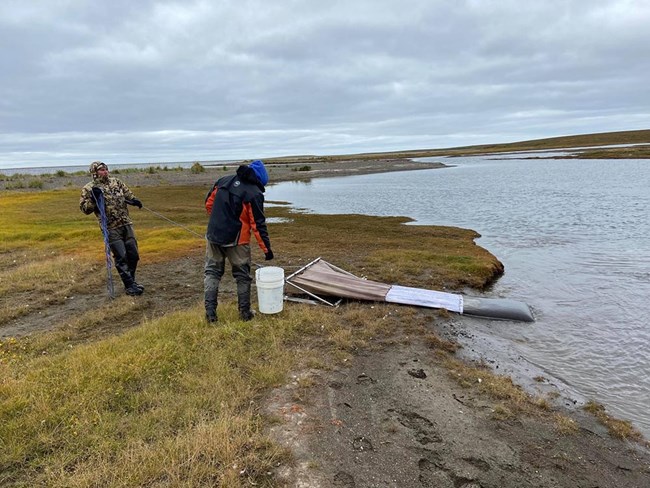Last updated: August 5, 2022
Article
Zooplankton in Cape Krusenstern National Monument Lagoons

Wildlife Conservation Society
Studying the basis of food webs is vitally important because it allows scientists to understand how energy flows through an ecosystem. In ecology, food webs encompass (1) diet patterns among a community of animals, (2) the transfer of energy through an ecosystem, and (3) predator-prey interactions. One of the most important components to all aquatic food webs – marine and freshwater – are zooplankton. Zooplankton are tiny organisms that represent the lower levels of the food chain and play a key ecological role in transferring energy from primary producers to predators such as fishes, terrestrial mammals, and waterfowl. Zooplankton are highly concentrated in nearshore environments such as coastal lagoons because shallow depths penetrated by sunlight, in combination with terrestrial-derived nutrients, promotes rapid zooplankton growth and reproduction.
In Northwest Alaska, including the Western Arctic Parklands, coastal lagoons are critical habitats for ecologically and culturally important fishes such as whitefishes, flounders, cods, salmon, and Pacific herring. Throughout different periods of the life histories of these fish, they utilize lagoons for spawning, rearing, and foraging. Many of these fish eat zooplankton, or the forage fishes that consume them, underlining the importance of this basal resource. However, while offshore Bering and Chukchi Sea zooplankton assemblages have been described, little information is known about their composition in lagoons, particularly species diversity, abundance, and distribution.
Therefore, to describe the zooplankton assemblages in coastal lagoons of Northwest Alaska, in 2017 and 2018 researchers from the Wildlife Conservation Society, University of Alaska Fairbanks, National Park Service, and the Native Village of Kotzebue Environmental Program undertook a study of eight lagoons within Cape Krusenstern National Monument and the Alaska Maritime National Wildlife Refuge (Cape Thompson). Zooplankton were collected with nets towed behind small inflatable boats, and water quality variables such as temperature, dissolved oxygen, salinity, and pH were measured to assess annual and geographic differences. After zooplankton collection, 75 samples were sent to the University of Alaska Fairbanks where Dr. Alexei Pinchuk classified individual organisms down to the lowest level possible and counted them. Although species diversity was low, the following zooplankton species were found: Acartia hudsonica, Eurytemora spp., juvenile cyclopoid and harpacticoid copepodites, Notostraca (Triops sp.), as well as freshwater Limnocalanus johanseni and Daphnia spp. Results were compared with limited data collected in historic ecological studies associated with the Red Dog Mine and Project Chariot.
As climate change impacts aquatic environments in the Arctic, changing seasonal periodicity, freshwater input, and connectivity to the ocean may alter zooplankton species diversity and abundance in lagoon environments. Through several years of research at Cape Krusenstern and Cape Thompson lagoons, this study demonstrated that there is variability in zooplankton species diversity and abundance between lagoons, yet zooplankton assemblage structure within lagoons and across years is quite stable. High abundances of zooplankton within some lagoons underlines the bountiful foraging opportunities for planktivorous fishes, which translates to plentiful, healthy prey bases for higher-level predators. Although it was found that zooplankton composition can remain consistent over decades, it will be important to monitor assemblages in the future given the dramatic effects of climate change in the Arctic.
Pinchuk, A, M. D. Robards, K. M. Fraley. 2020. Biological Productivity in Arctic Lagoons: Pilot Study to Assess Diversity, Abundance, and Interannual Dynamics of Zooplankton Populations. Wildlife Conservation Society Report.
